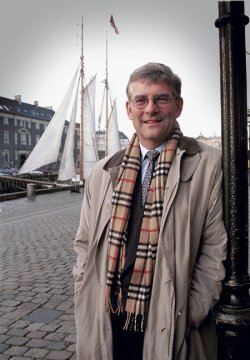SAS chief executive Jorgen Lindegaard is convinced the group’s Turnaround survival strategy is finally starting to pay dividends. But speaking to Airline Business at a sunny Copenhagen airport in early October, on his birthday, in fact, he admitted he still sees a number of big challenges for the future. He insists that number one on the agenda is “the ability to control our own destiny”. He adds: “Who knows what the industry will look like in 10 years’ time?
 He says the trend is towards more passengers bringing in less revenue as the business model moves away from higher-yield business travellers. According to Lindegaard, in 2000 60% of revenues came from business passengers – this has fallen to more like 20% in 2005. He says he would “sacrifice yield for loads, but we would have to be able to control it”.
He says the trend is towards more passengers bringing in less revenue as the business model moves away from higher-yield business travellers. According to Lindegaard, in 2000 60% of revenues came from business passengers – this has fallen to more like 20% in 2005. He says he would “sacrifice yield for loads, but we would have to be able to control it”.
Lindegaard is pleased with current load factors of 74% and says: “Although 74% is not what our low-cost competition is looking for, in a network carrier it is pretty good.” He predicts continued rationalisation for 2006, but laments that a lot of merger activity among the airlines is limited by bilateral agreements. “Ours is the only global industry that is not global,” he complains.
Labour costs could be an area of concern for SAS: the labour contracts that were agreed last year which obtained pay concessions from flight and cabin crews are due to expire next March. However, Lindegaard insists that SAS staff are well aware of the consequences of making excessive demands. He says that there must be an increase in productivity and a cut back in direct labour costs. “There is more to be achieved,” he adds.
As a further development of its Turnaround survival strategy, SAS has introduced a brand new business model across all the SAS group airlines, offering fully flexible one-way fares on all domestic and European services apart from Germany. The one-way fare concept is not unique, but the SAS offering means that passengers have the option to mix fare types and book seats in different classes on their outward and return sectors.
SAS aircraft operate with a three-class fare structure: economy, where tickets are non-transferable and non-flexible; economy flex, with fully flexible tickets and in which a complimentary meal and drinks are provided; and traditional business class.
Lindegaard is keen that cost levels for the group should be in line with the most efficient players for the basic product – a necessity following the explosion of low-cost competition in Scandinavia – but that additional costs for transfer, distribution, in-flight products and so on should be covered by a price premium. “You pay for what you get,” he insists.
Lindegaard admits that the SAS fleet is a particularly diverse one, from the Fokker 50 right up to the Airbus 340, but says the group does not have the resources to change it in the coming years.
Despite the high fuel costs of the Boeing MD-80, of which the group currently has 46 in active service, he says that overall he is satisfied with the performance of the aircraft. In its defence, the MD-80 has lower maintenance costs than almost any other aircraft in the group, he adds. He is clearly loath to add to the mix, and says: “I want to be the one chief executive of SAS that doesn’t add an aircraft type that after five years we don’t need!”
Click here for more Airline Business interviews
Source: Airline Business























